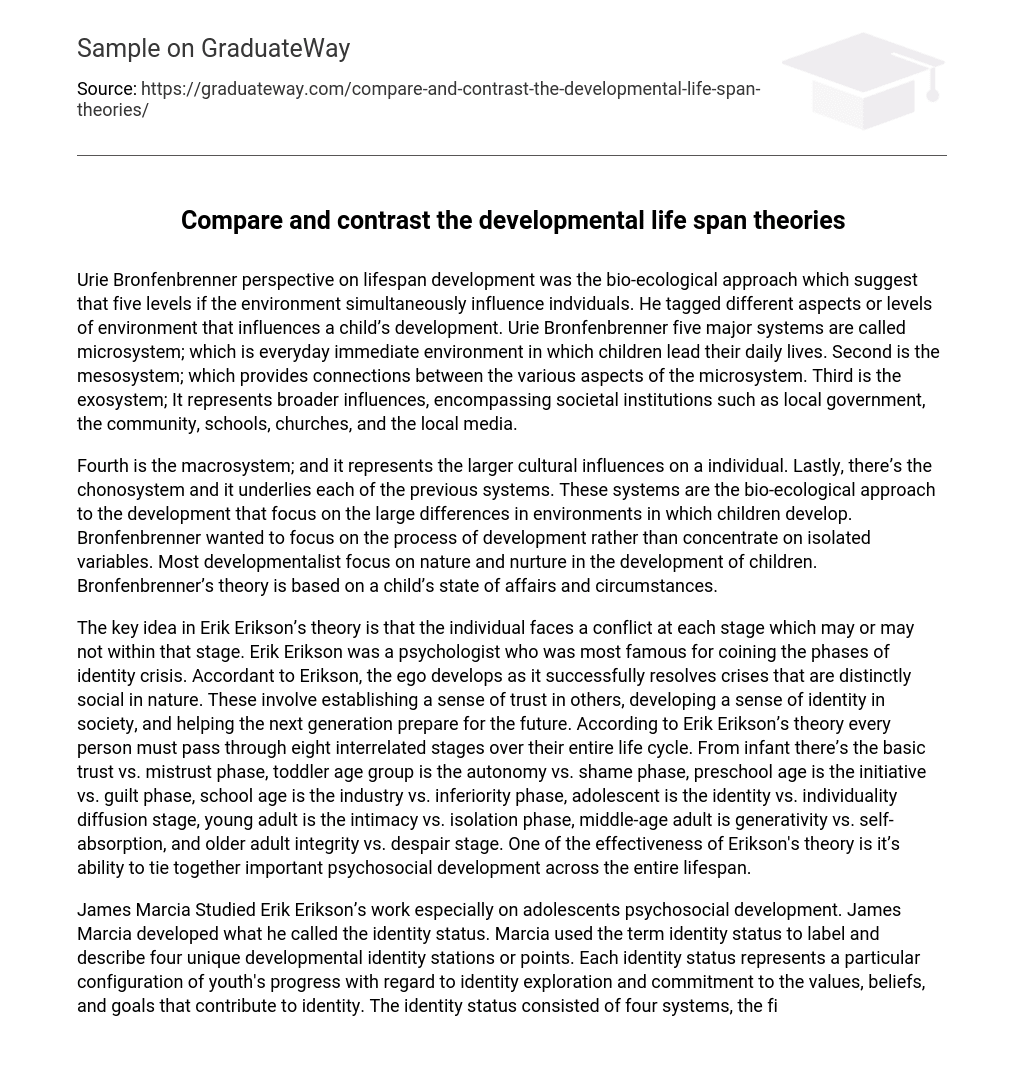Urie Bronfenbrenner perspective on lifespan development was the bio-ecological approach which suggest that five levels if the environment simultaneously influence indviduals. He tagged different aspects or levels of environment that influences a child’s development. Urie Bronfenbrenner five major systems are called microsystem; which is everyday immediate environment in which children lead their daily lives. Second is the mesosystem; which provides connections between the various aspects of the microsystem. Third is the exosystem; It represents broader influences, encompassing societal institutions such as local government, the community, schools, churches, and the local media.
Fourth is the macrosystem; and it represents the larger cultural influences on a individual. Lastly, there’s the chonosystem and it underlies each of the previous systems. These systems are the bio-ecological approach to the development that focus on the large differences in environments in which children develop. Bronfenbrenner wanted to focus on the process of development rather than concentrate on isolated variables. Most developmentalist focus on nature and nurture in the development of children. Bronfenbrenner’s theory is based on a child’s state of affairs and circumstances.
The key idea in Erik Erikson’s theory is that the individual faces a conflict at each stage which may or may not within that stage. Erik Erikson was a psychologist who was most famous for coining the phases of identity crisis. Accordant to Erikson, the ego develops as it successfully resolves crises that are distinctly social in nature. These involve establishing a sense of trust in others, developing a sense of identity in society, and helping the next generation prepare for the future. According to Erik Erikson’s theory every person must pass through eight interrelated stages over their entire life cycle. From infant there’s the basic trust vs. mistrust phase, toddler age group is the autonomy vs. shame phase, preschool age is the initiative vs. guilt phase, school age is the industry vs. inferiority phase, adolescent is the identity vs. individuality diffusion stage, young adult is the intimacy vs. isolation phase, middle-age adult is generativity vs. self-absorption, and older adult integrity vs. despair stage. One of the effectiveness of Erikson’s theory is it’s ability to tie together important psychosocial development across the entire lifespan.
James Marcia Studied Erik Erikson’s work especially on adolescents psychosocial development. James Marcia developed what he called the identity status. Marcia used the term identity status to label and describe four unique developmental identity stations or points. Each identity status represents a particular configuration of youth’s progress with regard to identity exploration and commitment to the values, beliefs, and goals that contribute to identity. The identity status consisted of four systems, the first one is called foreclosure; which is when a commitment is made without exploring alternatives. Second is identity diffusion; when adolescents are unable to face the necessity of identity development avoid exploring or making commitments by remaining in an amorphous state of identity diffusion, something which may produce social isolation. Third is moratorium; its that status of individuals who are in the midst of crisis, whose commitments are either absents or are only vaguely defined, but who are actively exploring alternatives. And lastly identity achievement; once a crisis has been worked through, James Marcia reasoned “a likely progression would be from diffusion through moratorium to identity achievement.
Although Erik Erikson, James Marcis, and Urie Brofenbrenner all had names stages and coined theories for lifespan development. Erik Erikson was the only one whose stages went through an individuals entire life. Because of that, if I had to choose a theory I sided with most it would definitely be Erik Erikson’s. He broke down negatives and positives for eah stage which made sense because there are up’s and down’s or negatives and positives that takes place in everyone’s life. As stated above according to Erik Erikson’s theory, during the first 18 months of life we pass through the trust versus mistrust stage. The trust versus the mistrust stage is based on how the infant is treated by his or her parents, grandparents, or caregivers which then has an effect on the next stage in a person’s life. This theory is a prime example of a child who is mistreated at birth, this placed in the system (foster care) then later on in life have troubles with autonomy versus shame and doubt, initiative versus guilt and so on and so forth which then determines one’s lifespan outcome.





